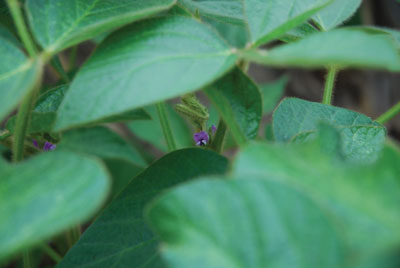
Features
Agronomy
Soybeans
Soybean planting dates
Farmers have often gone by the notion that corn planting should always come first, followed by soybeans.
November 30, 2011 By Treena Hein
Farmers have often gone by the notion that corn planting should always come first, followed by soybeans. But when the right conditions present themselves, it may be a better idea to plant some corn, get some or most of a soybean crop into the ground, then go back and finish the corn.
 |
|
| Varieties that flower for a longer period in the summer and produce more pods are attracting more growers. Photo by Ralph Pearce.
|
“Generally, I think it’s a great idea to get your soybeans in early if the soil is fit,” says certified crop advisor Alan McCallum, who is based in Elgin County. “I think the practice of waiting until all the corn is done to even consider planting soybeans is leaving some yield potential on the table.”
Yield potential increases with later-maturing soybeans, but how much actual yield can be gained by planting long-maturing soybean varieties? These varieties tend to flower for a longer period and produce more pods, observes Adam Pfeffer, a technical development representative with Monsanto Canada based in Chatham. However, farmers should remember that harvest of long-maturing varieties can delay winter wheat planting by a few days.
Planting date, germination rate (weather and soil conditions), as well as seasonal weather patterns and individual farm crop production practices such as weed, pest and disease management, also play a part in soybean yields. Many farmers are using treated seed, which can make a significant difference in stand establishment with early planting. “Soybean breeding is not generally focused on early season vigour,” notes Pfeffer. “We always check to make sure it’s adequate in each new variety, but the thinking is that seed treatments such as CruiserMaxx are the way to provide this.”
Pfeffer, along with Ontario Ministry of Agriculture and Food (OMAFRA) soybean specialist Horst Bohner and University of Guelph plant agriculture professor Dr. Hugh Earl are studying how late-maturing soybean varieties interact with planting dates in terms of yield. Funding for the 2010-2012 study is being provided by the Agricultural Adaptation Council, Grain Farmers of Ontario and the University of Guelph.
The trials involve measuring yield response to three soybean varieties with a range of maturities, planted at an early date (April 15 to May 5), a normal planting date (May 6 to 20) and a late date (May 21 to June 5). The trials are located near Seaforth, Chatham, Ridgetown, Elora and Kemptville, in Ontario, and Ayr, St. Hugues and Coteau-du-lac, in Quebec.
In terms of data analyzed thus far, Pfeffer says “Everyone remembers that the 2010 growing season was exceptional. There were above-average temperatures and timely rains throughout the year, with no significant insect or disease pressure at the test locations. Overall, we found that early-planted soybeans had outstanding yields, although the late-planted plots also had above-average yields.”
Pffefer would not hesitate to advise a farmer to try earlier planting of late-maturing varieties.
“Soybeans are more frost-tolerant than is generally believed,” he says. “Some growers don’t seem to know how soybeans can take a longer low-temperature spell than corn.” McCallum adds, “Soybeans are actually more tolerant to a mild frost than corn, but a hard frost will kill a soybean plant whereas it will only kill the top of corn plants. That’s why you have to be reasonable about early planting. But I definitely would advise giving early planting a try.”
The first 24 hours is crucial, so temperature forecasts need to be watched closely in terms of making decisions on early planting dates. “But in general, because soybeans flower in late July, springtime is not that critical to yield,” says Pfeffer. “Getting rain when flowering occurs is a much more important factor than when the crop went in.”
“This year (2011), planting was delayed in some areas until June, and it certainly didn’t necessarily reduce yield,” says McCallum. “The soybean crop got adequate moisture in August, September and October, in the Elgin County area and a good portion of southern Ontario, and that’s what counted.”